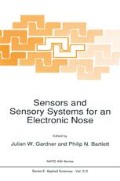Abstract
In this paper our three recent achievements of electronic noses are reviewed with the emphasis on Artificial Neural Networks (ANNs). The back-propagation algorithm has been used for identifying aromas of alcoholic beverages, and Fuzzy Learning Vector Quantization algorithm has been developed and is found promising for odour discrimination. The third is the analog ANN hardware which can be used in a compact odour sensing system. Those algorithms and a hardware system are discussed with respects to odour or gas identification capability.
Access this chapter
Tax calculation will be finalised at checkout
Purchases are for personal use only
Preview
Unable to display preview. Download preview PDF.
References
K. Ema, M. Yokoyama, T. Nakamoto and T. Moriizumi, Odour-sensing system using quartz-resonator sensor array and neutral-network pattern recognition, Sensors and Actuators, 18 (1989) 291–296.
D. E. Rumelhart, G. E. Hinton and R. J. Williams, Learning representations by back-propagating errors, Nature, 323 (1986) 533–536.
T. Nakamoto, K. Fukunishi and T. Moriizumi, Identification capability of odor sensor using quartz-resonator array and neural-network pattern recognition, Sensors and Actuators B, 1 (1990) 473–476.
T. Nakamoto, A. Fukuda, T. Moriizumi and Y. Asakura, Improvement of identification capability in odor sensing system, Sensors and Actuators B, 3 (1991) 221–226.
Y. Sakuraba, T. Nakamoto and T. Moriizumi, New method of learning vector quantization using fuzzy theory, Trans. Inst. Electron. Inf. Commun. Eng., J73D-II(1) (1990) 1863-1871 (in Japanese).
T. Kohonen, Self-Organization and Associative Memory, Springer-Verlag, 2nd edn., 1987, p.199.
T. Kohonen, G. Barna and R. Chrisley, Statistical pattern recognition with neural networks: benchmarking studies, Proc. of ICNN, I:I-61-I-68, 1987.
T. Nakamoto, H. Takagi and T. Moriizumi, An analog back propagation circuit. Trans. Inst. Electron. Inf. Commun. Eng., (in press).
G. Sauerbrey, Verwendung von Schwingquarzen zur waegung duenner schichten und zur mikrowaegung, Z. Phys., 155 (1985) 206–222.
W. H. King, Piezoelectric Sorption detector, Anal Chem., 36(9) (1964) 1735–1739.
T. Nakamoto and T. Moriizumi, A theory of quartz crystal microbalance based upon a mason equivalent circuit, Jpn. J. Appl. Phys., 29(5) (1990) 963–969.
D. E. Rumelhart, J. L. McClelland and The PDP Research group. Parallel Distributed Processing, MIT Press, 1986.
T. Nakamoto and T. Moriizumi, Odor sensor using quartz-resonator array and neural-network pattern recognition, in Proc. IEEE Ultrason. Symp., Chicargo, U.S.A., 1988, pp. 613-616.
T. Nakamoto, A. Fukuda and T. Moriizumi, Perfume and flavor identification by odor sensing system using quartz-resonator sensor array and neural-network pattern recognition, in Transducer’ 91 Technical Digest, San Fransisco, U.S.A, July 1991, pp. 355-358.
R. D. William and G. Matthew, Multivariate Analysis, John Wiley & Sons, New York, 1984.
C. A. Skarda and W. J. Freeman, How brains make chaos in order to make sense of the world, Behavioral and Brain Sciences, 10 (1987) 161–195.
A. Masaki and Y. Hirai, Neural networks in CMOS: a case study, IEEE Circuits and Devices Magazine, July 1990, pp. 12-17.
L. R. Anderson, S. Y. Foo and Y. Takefuji, Analog components for the VLSI of neural networks, IEEE Circuits and Devices Magazine, July 1990, pp. 18-26.
Author information
Authors and Affiliations
Editor information
Editors and Affiliations
Rights and permissions
Copyright information
© 1992 Springer Science+Business Media Dordrecht
About this chapter
Cite this chapter
Moriizumi, T., Nakamoto, T., Sakuraba, Y. (1992). Pattern Recognition in Electronic Noses by Artificial Neural Network Models. In: Gardner, J.W., Bartlett, P.N. (eds) Sensors and Sensory Systems for an Electronic Nose. NATO ASI Series, vol 212. Springer, Dordrecht. https://doi.org/10.1007/978-94-015-7985-8_14
Download citation
DOI: https://doi.org/10.1007/978-94-015-7985-8_14
Publisher Name: Springer, Dordrecht
Print ISBN: 978-90-481-4150-0
Online ISBN: 978-94-015-7985-8
eBook Packages: Springer Book Archive

